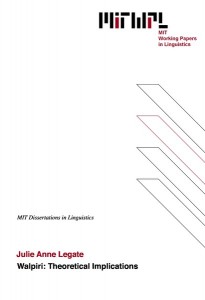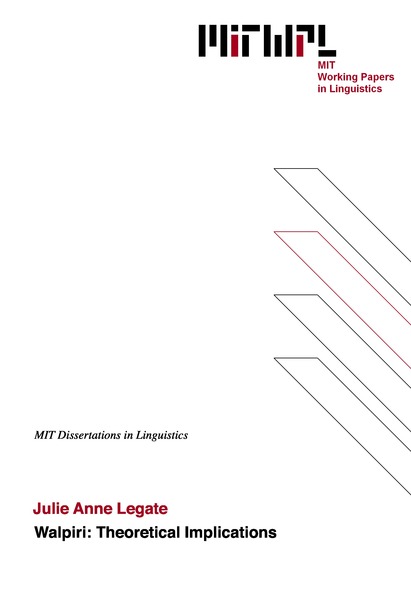Warlpiri: Theoretical Implications
J. A. Legate, 2002
The issue of non-configurationality is fundamental in determining the possible range of variation in Universal Grammar. This dissertation investigates this issue in the context of Warlpiri, the prototypical non-configurational language. I argue that positing a macroparameter, a single parameter that distinguishes configurational languages from non-configurational, requires variation on a magnitude not permitted by Universal Grammar. After refuting in detail previous macroparametric approaches, I propose a microparametric analysis: non-configurational languages are fully configurational and analysed through finegrained parameters with independent motivation. I develop this approach for Warlpiri, partially on the basis of new data collected through work with Warlpiri consultants and analysis of Warlpiri texts.
Beginning with A-syntax, I show that Warlpiri exhibits short-distance A-scrambling through binding and WCO data. I present an analysis of split ergativity in Warlpiri (ergative/absolutive case-marking, nominative/accusative agreement), deriving the split from a dissociation of structural case and its morphological realization, and the inherent nature of ergative case, rather than from non-configurationality. Extending the analysis to applicative constructions in Warlpiri, I identify both symmetric and asymmetric applicatives. I argue that the principled distinctions between them are explained structurally rather than lexically; therefore the applicative data provide evidence for a hierarchical verb phrase in Warlpiri. The analysis also reveals the first reported evidence for unaccusativity in the language.
Turning to A'-syntax, I argue that word order is not free in Warlpiri; rather Warlpiri displays an articulated left peripheral structure. Thus, word order variations are largely determined by positioning of elements in ordered functional projections based on information structure. Furthermore, I present evidence from WCO and island effects that elements appear in these projections through movement. Finally, I investigate the wh-scope marking construction, arguing for an indirect dependency approach. In developing the analysis, I argue, contrary to standard assumptions, that Warlpiri does have embedded finite complement clauses. On the basis of a poverty of the stimulus argument, I conclude the construction must follow from independent properties of the language. I propose that it follows from the discontinuous constituent construction, which I equate with split DPs/PPs in Germanic and Slavic languages.
The syntactic structure of Warlpiri that emerges from the dissertation strongly supports a configurational analysis of the language, and thereby the microparameter approach to nonconfigurationality.
Thesis Supervisor: Noam Chomsky
Title: Institute Professor of Linguistics and Philosophy
Thesis Supervisor: Sabine Iatridou
Title: Professor of Linguistics
| Table of Contents | |||
| 1 | Introduction | 12 | |
| 2 | Nonconfigurationality | 15 | |
| 2.1 | Introduction | 15 | |
| 2.2 | Basic Properties | 16 | |
| 2.3 | Analyses | 20 | |
| 2.3.1 | Dual Structure | 21 | |
| 2.3.2 | Pronominal Argument | 27 | |
| 2.3.3 | Secondary Predicate | 35 | |
| 2.3.4 | Conclusion | 39 | |
| 2.4 | Issues and Arguments I: Dual Structure | 39 | |
| 2.5 | Issues and Arguments II: Pronominal Argument | 47 | |
| 2.5.1 | Arguments for the PAH | 47 | |
| 2.5.2 | Arguments against the PAH | 70 | |
| 2.5.3 | Summary | 89 | |
| 2.6 | Issues and Arguments III: Secondary Predicate | 90 | |
| 2.7 | Towards a Microparameteric Account | 97 | |
| 2.8 | Conclusion | 117 | |
| 3 | A-syntax | 118 | |
| 3.1 | Introduction | 118 | |
| 3.2 | Split-Ergativity | 119 | |
| 3.2.1 | The Grammatical Subject | 120 | |
| 3.2.2 | Split Absolutive | 128 | |
| 3.2.3 | Typology | 139 | |
| 3.2.4 | Previous Analyses | 144 | |
| 3.2.5 | Ergativity and Nonconfigurationality | 153 | |
| 3.2.6 | Conclusions | 158 | |
| 3.3 | Applicatives | 159 | |
| 3.3.1 | Ditransitives | 160 | |
| 3.3.2 | Ethical Datives | 165 | |
| 3.3.3 | Implications | 167 | |
| 3.3.4 | A Structural Account | 170 | |
| 3.3.5 | Additional Evidence | 178 | |
| 3.3.6 | Conclusion | 189 | |
| 3.4 | Conclusion | 189 | |
| 4 | A'-syntax | 191 | |
| 4.1 | Introduction | 191 | |
| 4.2 | Left Periphery | 191 | |
| 4.2.1 | Topics | 197 | |
| 4.2.2 | Wh-phrases and Foci | 203 | |
| 4.2.3 | Heads | 209 | |
| 4.3 | Movement versus Base-generation | 213 | |
| 4.4 | Interpretation of Focus | 222 | |
| 4.5 | Wh-scope Marking | 229 | |
| 4.5.1 | Basic Properties | 231 | |
| 4.5.2 | Previous Analyses | 235 | |
| 4.5.3 | Warlpiri Background | 246 | |
| 4.5.4 | Warlpiri wh-scope marking | 264 | |
| 4.5.5 | Summary | 267 | |
| 5 | Conclusion | 269 | |

